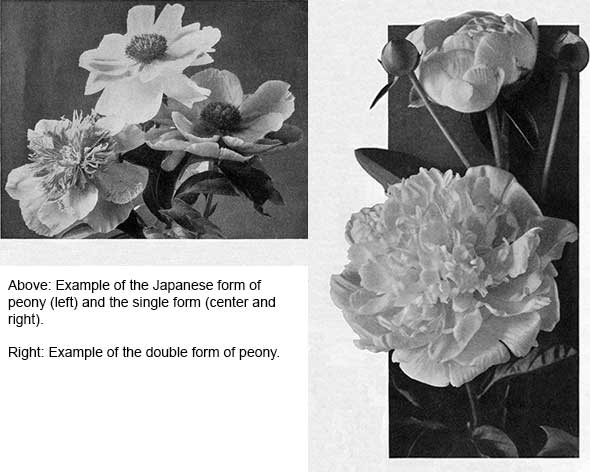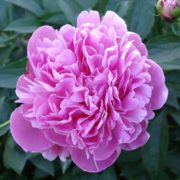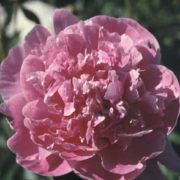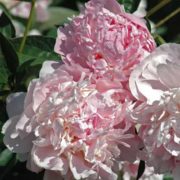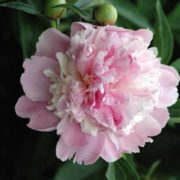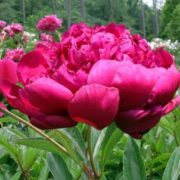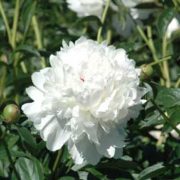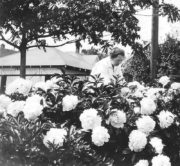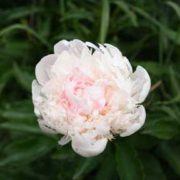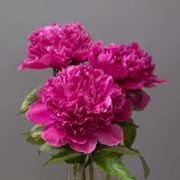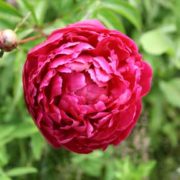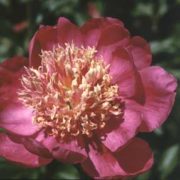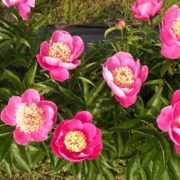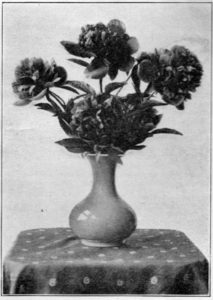Small Home Gazette, Spring 2018
Peonies for a Bungalow Garden
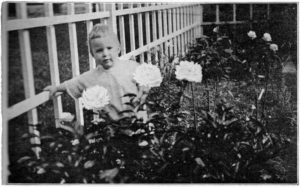 Peonies were, and still are, traditional flowers appropriate for bungalows. In the 1920s, the concept of foundation plantings, where shrubs are grouped around the house, was becoming popular. The large double flowers and shrub-like plant habit of peonies helped to frame a house and anchor it to its site. The peonies’ large blooms created an attractive picture and gave a welcoming impression to visitors.
Peonies were, and still are, traditional flowers appropriate for bungalows. In the 1920s, the concept of foundation plantings, where shrubs are grouped around the house, was becoming popular. The large double flowers and shrub-like plant habit of peonies helped to frame a house and anchor it to its site. The peonies’ large blooms created an attractive picture and gave a welcoming impression to visitors.
Another welcoming feature: Many of the classic peonies of this time period had a fragrance that made a lasting impression. They were plants that worked well in simple landscapes; were relatively easy to grow; and were moderate in price.
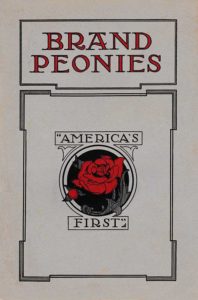 If your goal is to bring back authentic plants, consider peonies. By doing so, you will also help to conserve the older varieties. Many of the long-lived peonies grown since the early 1900s are still available with a little searching. Some varieties, however, are only offered by one or two growers world-wide.
If your goal is to bring back authentic plants, consider peonies. By doing so, you will also help to conserve the older varieties. Many of the long-lived peonies grown since the early 1900s are still available with a little searching. Some varieties, however, are only offered by one or two growers world-wide.
The Midwest, and especially Minnesota, has a legendary connection with some of the most well respected and popular peonies grown throughout the world today. For example, Brand Peony Farms, in the Faribault area, was the first commercial nursery in Minnesota. They specialized in growing and breeding peonies.
Let’s take a look at a dozen of the peonies grown in the landscapes of the bungalow heyday and the qualities that make them worthy of consideration for period-appropriate gardens.
The terms used in America to describe peony flower forms include: single, semi-double, Japanese, anemone, double and bomb; however, no definitive descriptions exist for these forms. In Minnesota, peonies typically bloom from the end of May through the last week in June, starting in the south and moving northward.
Edulis Superba is one of the most fragrant pink peonies during the bungalow era and is still in the top 10 of peonies known for fragrance. The translation of the name means superbly edible! Developed in 1824 by the French peony grower Monsieur Lemon, it is a dark pink double peony that is a true heirloom at close to 200 years old. It is worthy of a spot in your garden because of its abundance of blooms, fragrance, resistance to disease, and great “keeping” qualities as a cut flower.
Another classic and still popular variety is the very large and moderately fragrant Mons Jules Elie, introduced in 1888. Mons Jules Elie is an opaque pink double with broad, smooth guard petals and an incurved center. Its very large and fragrant blooms are one of the best for cut flowers. It will need staking because of the large flowers and 40-inch stems.
Sarah Bernhardt, a dark rose-pink double introduced in 1906 by French nurseryman and breeder Lemoine, is still easy to find. There are six billion stems of Sarah Bernhardt sold every year as a cut flower, often marketed in plastic bags in the spring at discount stores. Sarah Bernhardt is noted for incredible vigor and flower production, and for good foliage. While great in the garden and for cut flowers, the large fragrant flowers bloom on weak stems, so supports are needed. A mature plant can be over 4 feet wide so give it room to grow.
In the lighter pink-colored and very fragrant group, you should consider Brand’s 1913 introduction Chestine Gowdy. Later blooming, the full double flower has a bright pink center and guard petals separated by a collar of cream-colored petals, creating a unique effect. Slightly shorter at 26 to 30 inches tall, it is lovely in a bouquet and heavenly for the fragrance. Plant it generously along a fence for a plentiful supply of blooms to share with friends and family.
In the darker rose-pink doubles, the peony President Roosevelt, introduced by Warnaar in 1905, is a more loosely built double (or a double with fewer petals). Cherished as a fragrant peony, it is one of the last to bloom. Sometimes called a red by gardeners who think it too dark to be a pink, it is brilliant and striking: a very large semi-rose type, richly fragrant, and great for cut flowers. It is difficult to find.
While there are many double white peonies with center red flecks, the most popular of the time period was another French variety. Festiva Maxima was introduced by the French nurseryman Miellezin in 1851. Finding the real thing is difficult as there are many less robust-growing imposters with the same form but certainly not the large plant and flower habit that give this four-foot-tall peony its name.
The true Festiva Maxima is a tall, massive, globular white-with-red-flares double and is one of the oldest and still one of the best very-fragrant whites in the lactiflora species. The healthy, dark green and large foliage is distinctive. Like many peonies of this time period, it needs staking to support the large blooms. As a cut flower, it is very beautiful. When out of bloom, the dark green foliage remains attractive in the garden.
Peony Lady Alexandra Duff was introduced by the English nursery Kelways and Sons in 1902. It has a superb double blush lavender-pink bloom with a large center surrounded by smaller semi-double side buds, so a single stem makes a whole bouquet. Strong stems are floriferous (bloom freely) with a graceful garden effect. It grows to 36 inches tall.
In the red-colored peonies of the time, the following three are excellent.
Peony Felix Crousse was introduced by French horticulturist Crousse in 1881 and is a large, red double peony noted for its heavy flower production and “keeping” qualities when used as a cut flower. It is a fine heirloom variety worth restoring in your bungalow period garden.
Peony Karl Rosenfield was introduced by Nebraska breeder Rosenfield in 1908. This is a very showy flower for the garden and as a cut flower. The flowers are late-blooming, large, fragrant, deep red doubles with a semi-rose form and great foliage.
Peony Mary Brand was introduced by Brand Peony Farms in 1907. It is a dark, claret red rose-type double with a brilliant sheen that is still turning heads after 110 years. It blooms midseason and makes a great garden display. Only 28 inches tall with good dark green foliage, it is one of the shorter growing peonies with exceptional “keeping” quality as a cut flower.
The last two peonies are of the Japanese form, very different from the doubles we are used to. This form is characterized by very wide outer petals and a fine cluster of narrow petals, often of a different color in the center of the flower. Both of these Japanese peonies are known for incredible vigor, disease resistance, and a huge number of blooms.
Peony Mikado from Japan in 1893 has a wonderful floral presentation in the garden. The flowers are held above the foliage in a horizontal plane, giving a high visual impact in the garden. The bloom has cupped red outer petals with a rose and yellow center on strong, tall stems. Because of its vigor and prodigious flower production, Mikado is one of the most widely grown of all the Japanese form peonies. This one has been handed down in many families, and if you are looking to find a long-lived and dependable peony that will not flop over in bloom, it is a perfect choice.
Peony Tokio was introduced from Japan via the French peony grower Dessert in 1910. Tokio, a rosy pink Japanese-form peony, is an amazingly fast grower with broad rounded petals, giving it a full appearance in the garden and creating a wonderful flower show. The dark green foliage brings out the bright color of the blooms held on 36-inch stems.
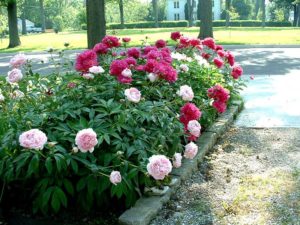 Peonies grow best in USDA Growing Zones 3 – 8, cold climate areas with hard freezes for extended periods during the winter. Success with peonies depends on a few key points. Plant them in full sun. Whenever possible, stay out of the shadow of trees and shrubs. This will also avoid interference from roots that can compete for moisture and nutrients.
Peonies grow best in USDA Growing Zones 3 – 8, cold climate areas with hard freezes for extended periods during the winter. Success with peonies depends on a few key points. Plant them in full sun. Whenever possible, stay out of the shadow of trees and shrubs. This will also avoid interference from roots that can compete for moisture and nutrients.
Fall, which is the normal rooting period for peonies, is the preferred planting time. In placing an order for bare roots, order early enough to reserve the roots for mid- to late-September shipping.
Dormant buds (or eyes) on the roots should be positioned about one inch below the surface when first planted and mulched the first winter with dry leaves or straw. Firm up the soil underneath the roots to prevent settling.
Peonies emerge early in the spring, so placement of any garden supports should be done as early as the first few days in April.
 Fertilizer may be applied in the form of a bulb fertilizer the last week in June every two to three years.
Fertilizer may be applied in the form of a bulb fertilizer the last week in June every two to three years.
Cutting down the foliage after a hard frost in the fall is recommended to help reduce any disease.
Discover something grand to restore your bungalow garden to its former glory with any of these fine peonies.
Resources
American Peony Society
americanpeonysociety.org
(For names of nurseries, visit americanpeonysociety.org/links/buy-peonies)
Hidden Springs Flower Farm
hiddenspringsflowerfarm.com
The author and his wife, Brigitte, operate Hidden Springs Flower Farm in Spring Grove, Minnesota, where they grow over 23,000 peonies consisting of 600 varieties at their nursery. They host an annual cut flower show the first weekend in June. More information can be found on their Facebook page or website.









